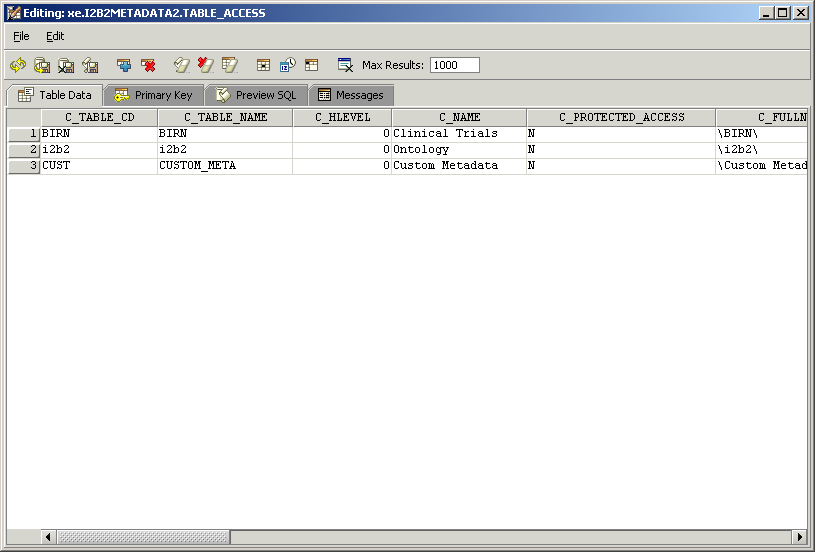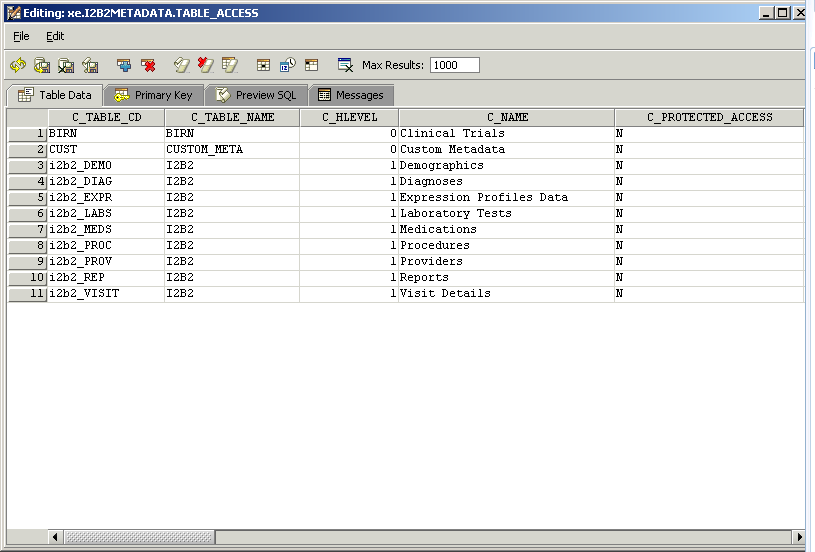RequestONT ServerOntology WebserviceusesRequest DAODatabase Vocabulary
Data ObjectusesencapsulatescreatesobtainsResponseRequest Handler
The Request Handler determines which Persistent Storage Location (PSL) is associated with a project request.
Sequence Diagram
Business ObjectData Access ObjectData SourceTransfer Object1. Create2. Get Data2.1. Get Data2.2. Create2.3. Return Object
Mappings of Styles
The following table is a mapping between the elements in the Component & Connector Client-Server view shown in section 3.1.1, and the Modules Decomposition and Uses views shown in sections 3.2.1 and 3.2.2.
The relationship shown is is-implemented-by, i.e. the elements from the C&C view shown at the top of the table are implemented by any selected elements from the Modules views, denoted by an "X" in the corresponding cell.
| ONT Server | Project Management Server | Metadata Database |
ONT Service | X | X |
|
Ontology Webservice | X |
|
|
Request Handler | X |
|
|
Request DAO | X |
| X |
Vocabulary Data Object | X |
|
|
Data View
Selecting the Data Source
Both the metadata and the patient data are distributed to projects through the existence of independent databases (in SQL Server) or schemas (in Oracle). These will be referred to in the rest of the text as the "persistent storage location" or PSL. These PSL's are organized so that the data from two metadata representations can be merged to a "Super" data set. While a person is working on a specific project, they will be directed to data in a PSL associated with that project.
In order to support the i2b2 project distribution strategy, the user is enrolled in numerous projects recorded within the i2b2 project management cell". The projects available to the user are returned in the web service call to the Project Management cell. The logic of selecting the correct PSL for the project is embodied in the following table:
DB_LOOKUP |
|
|
PK | c_domain_id | VARCHAR(255) |
PK | c_project_path | VARCHAR(255) |
PK | c_owner_id | VARCHAR(255) |
| c_db_fullschema | VARCHAR(255) |
| c_db_datasource | VARCHAR(255) |
| c_db_servertype | VARCHAR(255) |
| c_db_nicename | VARCHAR(255) |
| c_db_tooltip | VARCHAR(255) |
| c_comment | CLOB |
| c_entry_date | DATE |
| c_change_date | DATE |
| c_status_cd | CHAR(1) |
The logic for selecting the PSL is as follows:
- There are two methods to select the correct PSL, an implicit one, and an explicit one. Both rely only on information available within the i2b2 header.
- The implicit one relies upon the data within the <domain> tag, the <username> tag, and the <project_id> tag.
- The explicit one relies upon the data only within the <project_id> tag. It has the format represented as the following string:
"DOMAIN" | "Project" | "USER_ID" |
- These may not actually match the domain and username that is actually being used (since it is being built by the client), and must be checked when the PM cell is accessed.
- The table is meant to provide a series of default locations if ones are not specifically listed. If a project is listed in the _c_project_path_ column, then that PSL may be used, otherwise, a domain source will be used.
- If a username is listed in the _c_owner_id_ column, then if the project also matches the project_id, the PSL in that row may be used, otherwise, a project PSL will be used, and if a project PSL does not exist, the domain PSL will be used. For example, only if the domain|project|user_id is an EXACT match to the entries in the database will that PSL be used.
- The project may not have an entry in the table, and in that case any project would be designated the PSL of the domain.
- If a general domain PSL is not available in the table, and only a specific project is associated with the domain in the table, then any incoming messages not associated with that project will return an error.
- In the table, the "@" character is used to represent the absence of an entry (rather than a blank or a null).
- In the explicit string and in the <project_id>, and "@" can be used to optionally represent a blank.
Other columns are specified as follows:
- The column _c_db_fullschema_ is used to contain the path to a table when the data source is used. Software is written so that the absence of the delimiter (usually a ".") does not need to be explicitly stated.
- The column _c_db_datasource_ is used to contain a short string that represents a data source configured in some other location.
- The column _c_db_servertype_ can be "ORACLE" or "SQLSERVER".
- The column _c_db_nicename_ is a string that can be used in client software to describe a data source.
- The column _c_db_tooltip_ contains a longer (hierarchical) representation of the nicename.
To restate, many cells need to access some kind of persistent storage, and these cells will organize their persistent storage so that it is self contained and can be apportioned in a way consistent with the project-based requirements of i2b2 described above. To that end, a table exists in many cells to make the decision of what persistent storage location to which a specific user will be directed, depending on the project and domain to which they are associated.
Schemas within the metadata data source
The following schemas provide data used by the ONT system:
Table_Access table
This table is used to obtain a list of root elements of the Metadata tree. Each root element of the tree is represented by a single row in this table. The primary identifier of each Metadata root element in the Table_Access table is in the "{}c_table_cd" column. All messages that need to point to a specific Metadata root element will use this identifier, for example in the <Key> element of many messages where this identifier is represented as
c_table_name_ (see messaging specification). Within the _c_table_name column is the actual name in the PSL of the Metadata table. The _c_protected_access_ boolean column designates whether one must have the protected access role (data_prot) to obtain data from this table. The other columns are defined in a similar manner to the columns of the Metadata table, with the following special notes:
The _c_dimcode_ is used to allow the entire contents of a table to be queried in the data repository if the dimension table of the data repository has been set up in this fashion. While the _c_hlevel_ is traditionally 0 in this table (indicating one metadata table for each root element of the metadata tree), it is possible to 'flatten' the metadata tree so that multiple entries of single metadata table appear as root nodes. (see examples below)
TABLE_ACCESS |
|
|
PK | c_table_cd | VARCHAR(50) |
| c_table_name | VARCHAR(50) |
| c_protected_access | CHAR(1) |
| c_hlevel | INT |
| c_name | VARCHAR(2000) |
| c_fullname | VARCHAR(700) |
| c_synonym_cd | CHAR(1) |
| c_visualattributes | CHAR(3) |
| c_tooltip | VARCHAR(900) |
| c_total_num | INT |
| c_basecode | VARCHAR(50) |
| c_comment | CLOB |
| c_metadataxml | CLOB |
| c_facttablecolumn | VARCHAR(50) |
| c_dimtablename | VARCHAR(50) |
| c_columnname | VARCHAR(50) |
| c_columndatatype | VARCHAR(50) |
| c_operator | VARCHAR(10) |
| c_dimcode | VARCHAR(700) |
| c_entry_date | DATE |
| c_change_date | DATE |
| c_status_cd | CHAR(1) |
| valuetype_cd | VARCHAR(50) |
A traditional table_access table is shown below: it has one entry for each table.
The following table_access table shows entries for multiple root elements from a single metadata table. The nine I2B2 elements shown here appear under the 'Ontology' root element in the example above, resulting in a 'flattened' hierarchy.
Metadata tables
The Metadata table encapsulates the vocabulary used in the data repository. A term (concept or provider) is a row from the Metadata table. It is the primary object used to pass vocabulary information to the requesting client. Typically a PSL will contain numerous Metadata tables, each with a name that indicates the domain that the vocabulary contained within represents.
METADATA |
|
|
PK | c_fullname | VARCHAR(700) |
PK | c_name | VARCHAR(2000) |
| c_hlevel | INT |
| c_synonym_cd | CHAR(1) |
| c_visualattributes | CHAR(3) |
| c_tooltip | VARCHAR(900) |
| c_total_num | INT |
| c_basecode | VARCHAR(50) |
| c_comment | CLOB |
| c_metadataxml | CLOB |
| c_facttablecolumn | VARCHAR(50) |
| c_tablename | VARCHAR(50) |
| c_columnname | VARCHAR(50) |
| c_columndatatype | VARCHAR(50) |
| c_operator | VARCHAR(10) |
| c_dimcode | VARCHAR(700) |
| update_date | DATE |
| download_date | DATE |
| import_date | DATE |
| sourcesystem_cd | VARCHAR(50) |
| valuetype_cd | VARCHAR(50) |
Also included in this table are modifiers associated with the terms contained within the Metadata table. The column 'm_applied_path' specifies the concept path, or c_fullname, of the concept the modifier is associated with. If a modifier applies to a concept and its descendents the 'm_applied_path' is appended with a '%'. Entries in the metadata table that are not modifiers should have the 'm_applied_path' set to '@'.
Additionally, its possible to specifiy concept(s) a modifier is not associated with. Assume a modifier has been assigned to a root concept and its descendents with an applied path of '\Diagnoses%'. To exclude this modifier from a child ('Mental disorders') of the root concept ('Diagnoses') we add an entry for the modifier with an applied path of '\Diagnoses\Mental disorders\' and set the exclusion_cd to 'X'. If we had wished to exclude this modiifer from the descendents of 'Mental disorders' we would append the applied path with a '%'.
Finally, in Release 1.6, we added two optional columns in support of external tools. The column 'c_path' contains the c_fullname of a node's parent. The column 'c_symbol' is a unique, abbreviated form of the node's c_name. A node's c_path, concatenated with its c_symbol form the node's c_fullname.
Schemes table
The Schemes schema contains the unique prefixes obtained by different source codes. For example codes from the National Drug Code are prepended with the 'NDC' prefix, while codes from the United Medical Language System are prepended with the 'UMLS' prefix. This schema contains all the schemes recognized by the ONT system.
SCHEMES |
|
|
PK | c_key | VARCHAR(50) |
| c_name | VARCHAR(5) |
| c_description | VARCHAR(100) |
An example of a Schemes table is shown below:
Process Status table
Release 1.5 introduced the ablility to create new metadata or edit existing metadata within the i2b2 workbench. Once metadata has been created or edited it is necessary to synchronize these changes with the appropriate dimension table. The concept_dimension table would need to be updated with new concept terms; likewise provider_dimension table would need to be updated with new provider terms and the modifier_dimension table could need to be updated with new modifier terms.
The Process Status table provides information about the synchronization between the ontology metadata tables and the dimension tables.
PROCESS STATUS |
|
|
PK | process_id | INT |
| process_type_cd | VARCHAR(50) |
| start_date | DATE |
| end_date | DATE |
| process_step_cd | VARCHAR(50) |
| process_status_cd | VARCHAR(50) |
| crc_upload_id | VARCHAR(5) |
| status_cd | VARCHAR(50) |
| message | VARCHAR(2000) |
| entry_date | DATE |
| change_date | DATE |
| changedby_char | CHAR(50) |
Deployment View
Global Overview
ONT ClientInternetWebServerJ2EE ApplicationServerDatabase ServerWebservicePM Service
Detailed deployment model
ontology.aarontology-server.jarontology-core.jar<<deployment>><<deployment>><<deployment>>JBoss Application ServerOracleDatabaseServer


